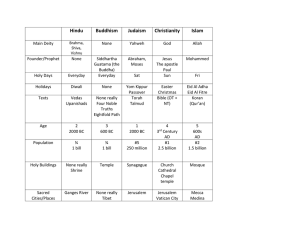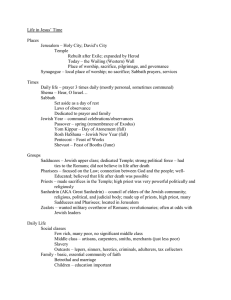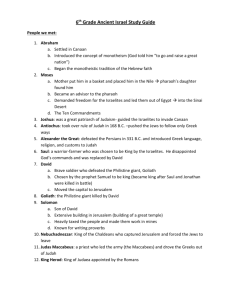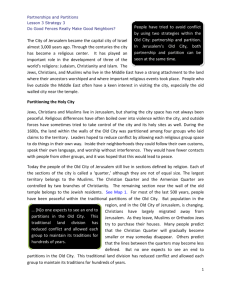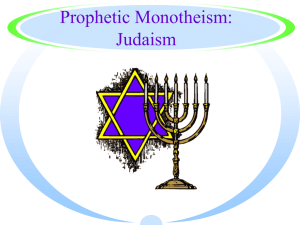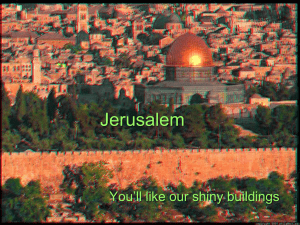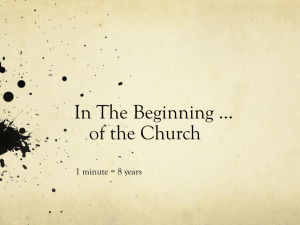Why everyone fights over Jerusalem
advertisement
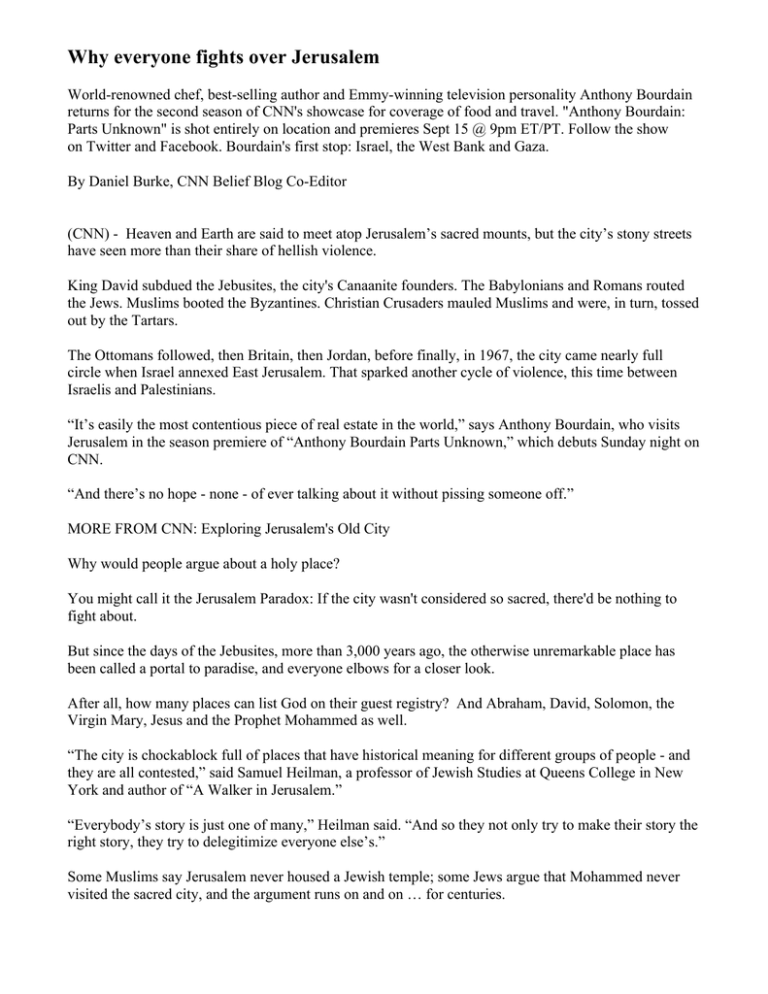
Why everyone fights over Jerusalem World-renowned chef, best-selling author and Emmy-winning television personality Anthony Bourdain returns for the second season of CNN's showcase for coverage of food and travel. "Anthony Bourdain: Parts Unknown" is shot entirely on location and premieres Sept 15 @ 9pm ET/PT. Follow the show on Twitter and Facebook. Bourdain's first stop: Israel, the West Bank and Gaza. By Daniel Burke, CNN Belief Blog Co-Editor (CNN) - Heaven and Earth are said to meet atop Jerusalem’s sacred mounts, but the city’s stony streets have seen more than their share of hellish violence. King David subdued the Jebusites, the city's Canaanite founders. The Babylonians and Romans routed the Jews. Muslims booted the Byzantines. Christian Crusaders mauled Muslims and were, in turn, tossed out by the Tartars. The Ottomans followed, then Britain, then Jordan, before finally, in 1967, the city came nearly full circle when Israel annexed East Jerusalem. That sparked another cycle of violence, this time between Israelis and Palestinians. “It’s easily the most contentious piece of real estate in the world,” says Anthony Bourdain, who visits Jerusalem in the season premiere of “Anthony Bourdain Parts Unknown,” which debuts Sunday night on CNN. “And there’s no hope - none - of ever talking about it without pissing someone off.” MORE FROM CNN: Exploring Jerusalem's Old City Why would people argue about a holy place? You might call it the Jerusalem Paradox: If the city wasn't considered so sacred, there'd be nothing to fight about. But since the days of the Jebusites, more than 3,000 years ago, the otherwise unremarkable place has been called a portal to paradise, and everyone elbows for a closer look. After all, how many places can list God on their guest registry? And Abraham, David, Solomon, the Virgin Mary, Jesus and the Prophet Mohammed as well. “The city is chockablock full of places that have historical meaning for different groups of people - and they are all contested,” said Samuel Heilman, a professor of Jewish Studies at Queens College in New York and author of “A Walker in Jerusalem.” “Everybody’s story is just one of many,” Heilman said. “And so they not only try to make their story the right story, they try to delegitimize everyone else’s.” Some Muslims say Jerusalem never housed a Jewish temple; some Jews argue that Mohammed never visited the sacred city, and the argument runs on and on … for centuries. And it’s not just Muslims, Christians and Jews fighting each other. Sometimes the most serious squabbles erupt within the faith themselves. Want to see Christian monks fist-fight? Go to Jerusalem. The good news is, all three Abrahamic faiths teach that the Messiah will eventually return to Jerusalem and sort the whole thing out. Until then, here are the sacred city’s five most contested sites: 1. The Temple Mount This broad platform in Jerusalem’s Old City is said to have hosted an almost unimaginable series of sacred events. The rabbinic sages say that God gathered dust from this spot to create Adam, the first man, before setting him loose in the Garden of Eden. Jewish tradition holds that the Temple Mount also contains Mount Moriah, where Abraham, the Hebrew patriarch, is said to have nearly sacrificed his son - under God’s orders - before an angel intervened. Later, Solomon constructed the first Jewish Temple on the mount, including the Holy of Holies, a room that kept the Ark of the Covenant, which was said to contain the tablets on which God wrote the Ten Commandments. Only the Jewish high priest was allowed to enter the Holy of Holies, where tradition holds he met with God on Yom Kippur, the Jewish Day of Atonement. Rabbis say that Jews are still forbidden to step on the Temple Mount, for fear of intruding on the Holy of Holies. The Temple was destroyed twice, first by the Babylonians and then by the Romans. Religious Jews pray the Third Temple will be built by the Messiah himself. Since 1967, the Temple Mount has been an almost constant source of tension because it is also home to the … 2. Haram al-Sharif Muslims call the Temple Mount "Haram al-Sharif" (the Noble Sanctuary), and it's home to one of the most sacred sites in Islam: the al-Aqsa Mosque. Muslims believe that the Prophet Mohammed was carried on a flying steed from Mecca to al-Aqsa during his miraculous Night Journey, said Muqtedar Khan, an expert on Islam and politics at the University of Delaware. “It’s al about al-Aqsa,” said Khan. “That’s why all Muslims are sympathetic to the Palestinian cause.” According to Islamic tradition, the night journey took Mohammed to the same Jerusalem rock on which Abraham nearly sacrificed his son, where the Muslim founder led Abraham, Moses and Jesus in prayers as the last of God's prophets. That rock is now said to sit in the Dome of the Rock, whose golden roof gleams above the Old City skyline. Since it's construction in the seventh century, the Haram al-Sharif, now controlled by an Islamic trust, has been an almost constant source of tension between Muslims and Jews. In the 1980s, Jewish radicals plotted to blow up the Dome of the Rock and al-Aqsa, believing that it would lead to a spiritual revolution and usher in the messiah. In 2000, the Second Intifada – a five-year-long Palestinian uprising - was sparked, Palestinians say, after Ariel Sharon, then a candidate for Israeli Prime Minister, visited the compound surrounding al-Aqsa. Sharon insisted that his visit was not intended to provoke Palestinians, but many saw it as an attempt to underline Israel’s claim to Jerusalem’s holy sites. 3. The Western Wall Israeli soldiers wept when they saw the Western Wall in 1967, after seizing East Jerusalem from Jordan. “We have returned to our most holy places,” said one Israeli general. “We have returned and we shall never leave them.” Located at the foot of the Temple Mount, the 62-foot-tall stone wall once supported the courtyard of the ancient temple, the center of Jewish spiritual life for centuries. For Jews, the wall is one of the last remaining links to that time, and they gather before it to hold religious services, to pray or to slip notes into its cracks. “There's a tradition that notes put in the wall are like notes transmitted to heaven,” Heilman said, “since this is as close as Jews were able for generations to get to the Temple Mount where they believed God dwelt on earth.” How close Jews get - and which kind of Jews - has been a subject of fierce debate in recent years. The praying area is divided into men’s and women’s sections, and ultra-Orthodox men have hurled chairs at women who sing and pray at the wall or try to enter the men’s section, accusing them of violating Jewish law. In response, a group called Women of the Wall has launched a highly publicized protest campaign to win the right to wear prayer shawls, lead prayers and read collectively from the Torah at the holy site. 4. The Church of the Holy Sepulchre In the fourth century, after converting to Christianity, Emperor Constantine launched what historian Karen Armstrong calls “one of the first recorded archaeological excavations in history.” He was looking for Jesus’ tomb and thought he found it in Jerusalem. Constantine asked his mother to oversee the construction of a magnificent church on the site. Originally called the Church of Resurrection, it was destroyed by a Muslim caliph in 1009, but later Muslim leaders allowed Christians to rebuild the church. Now called the Church of the Holy Sepulchre, it is believed by many Christians to house a piece of the cross on which Jesus was crucified, his tomb and the site of his resurrection. Under a centuries-old agreement, the church is shared by six Christian communities, but they squabble over every stone, sometimes coming to blows over perceived slights. In 2008, for example, Israeli riot police broke up a melee between Greek Orthodox and Armenian monks. Ethiopian monks reportedly sneaked into the church's rooftop monastery during Easter prayers in 1970 and changed the locks, evicting the its former owners, the Copts. The six Christian communities at the Holy Sepulcher don’t even trust each other with the church keys. A Muslim family has held them, opening the church every morning and closing it every night since the 12th century. 5. The Garden Tomb Not all Christians believe that Jesus was buried and rose again at the Church of the Holy Sepulchre. In the 19th century, doubts crept in about Constantine’s site, said Robert Wilken, a professor of Christian history at the University of Virginia. “What it really boils down to is that Protestants came to the Church of the Holy Sepulchre in the 19th century and were appalled that it was an Orthodox church,” Wilken said. The icons and incense were apparently too much for Protestants more austere sensibilities. In 1867, British Christians unearthed what they believe was the garden of Joseph of Arimathea, outside the Old City's Damascus Gate, where they believe Jesus was entombed. The Gospel of John says that Jesus' tomb was near a garden, and the British Christians who run the Garden Tomb say their site matches the Bible’s descriptions perfectly. The tomb is carved from solid rock, it sits near an escarpment that looks like a skull (Golgotha, where Jesus was crucified, means “place of the skull,”) and most importantly, they say, the tomb is empty, signifying a resurrected Jesus. So, is there any chance the battle for Jerusalem will end before the End Times? Muqtedar Khan says yes, if the traditions that trace their history to Abraham - Jews, Muslims and Christians - start seeing themselves as part of the same sacred lineage, rather than three separate religions. "If there were willing to share this identity," Khan said, "perhaps they'd be more willing to share Jerusalem." Daniel Burke - CNN Belief Blog Co-Editor Source: http://religion.blogs.cnn.com/2013/09/15/the-battle-for-jerusalem-the-sacred-citys-five-most-contested-sites/
